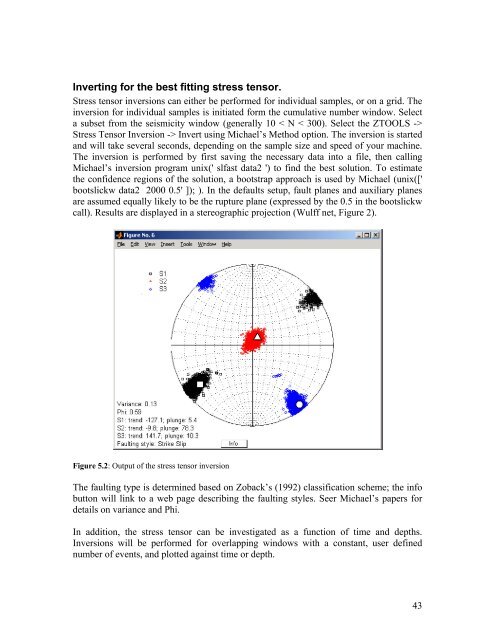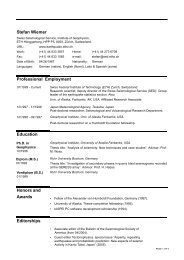zmap a tool for analyses of seismicity patterns typical applications ...
zmap a tool for analyses of seismicity patterns typical applications ...
zmap a tool for analyses of seismicity patterns typical applications ...
Create successful ePaper yourself
Turn your PDF publications into a flip-book with our unique Google optimized e-Paper software.
Inverting <strong>for</strong> the best fitting stress tensor.<br />
Stress tensor inversions can either be per<strong>for</strong>med <strong>for</strong> individual samples, or on a grid. The<br />
inversion <strong>for</strong> individual samples is initiated <strong>for</strong>m the cumulative number window. Select<br />
a subset from the <strong>seismicity</strong> window (generally 10 < N < 300). Select the ZTOOLS -><br />
Stress Tensor Inversion -> Invert using Michael’s Method option. The inversion is started<br />
and will take several seconds, depending on the sample size and speed <strong>of</strong> your machine.<br />
The inversion is per<strong>for</strong>med by first saving the necessary data into a file, then calling<br />
Michael’s inversion program unix(' slfast data2 ') to find the best solution. To estimate<br />
the confidence regions <strong>of</strong> the solution, a bootstrap approach is used by Michael (unix(['<br />
bootslickw data2 2000 0.5' ]); ). In the defaults setup, fault planes and auxiliary planes<br />
are assumed equally likely to be the rupture plane (expressed by the 0.5 in the bootslickw<br />
call). Results are displayed in a stereographic projection (Wulff net, Figure 2).<br />
Figure 5.2: Output <strong>of</strong> the stress tensor inversion<br />
The faulting type is determined based on Zoback’s (1992) classification scheme; the info<br />
button will link to a web page describing the faulting styles. Seer Michael’s papers <strong>for</strong><br />
details on variance and Phi.<br />
In addition, the stress tensor can be investigated as a function <strong>of</strong> time and depths.<br />
Inversions will be per<strong>for</strong>med <strong>for</strong> overlapping windows with a constant, user defined<br />
number <strong>of</strong> events, and plotted against time or depth.<br />
43



